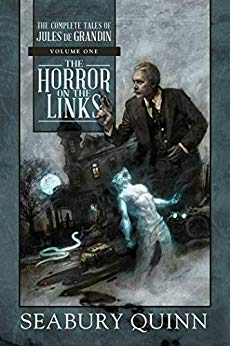 “The Horror on the Links”, by Seabury Quinn, first presented in Weird Tales, introduces the adventures of the French occult detective, Jules de Grandin. De Grandin is a step on the progression from Semi-Dual, one of the earliest–if not *the* first–occult detective, to the weird menace of Marvel and beyond. (The Pulp Super Fan has an excellent introduction to Semi-Dual, whose Argosy stories we will see soon.) Seabury Quinn’s Jules de Grandin stories were a cornerstone of Weird Tales throughout the Farnsworth Wright era. Today, however, he is overshadowed by Howard, Lovecraft, and Clark Ashton Smith.
“The Horror on the Links”, by Seabury Quinn, first presented in Weird Tales, introduces the adventures of the French occult detective, Jules de Grandin. De Grandin is a step on the progression from Semi-Dual, one of the earliest–if not *the* first–occult detective, to the weird menace of Marvel and beyond. (The Pulp Super Fan has an excellent introduction to Semi-Dual, whose Argosy stories we will see soon.) Seabury Quinn’s Jules de Grandin stories were a cornerstone of Weird Tales throughout the Farnsworth Wright era. Today, however, he is overshadowed by Howard, Lovecraft, and Clark Ashton Smith.
“Physicians’ sleep is like a park—public property.” With that lamentation, Dr. Trowbridge is summoned to treat the long gashed wounds of Paul Maitland, who, in his delirium, cries out about an ape-thing chasing him. Meanwhile:
“Almost entirely denuded of clothing, marred by a score of terrible wounds, her face battered nearly past recognition and her neck broken, the body of pretty Sarah Humphreys, was found lying in one of the bunkers of the dub’s golf course this morning.”
Sarah’s wounds are similar to Paul’s. Dr. Trowbridge, as Paul Maitland’s physician is drawn into the investigation, headed by Sergeant Costello, and assisted by a criminologist, Jules de Grandin. De Grandin’s renown in the scientific world is such that Trowbridge recognizes his work.
Upon questioning, Paul says he was attacked by a hairy ape near the golf course. An examination of Sarah’s body confirms the unlikely story.
“It’s terrible–“
“But certainly, One does not look to see the beautiful in the morgue. I ask for what you see, not for your aesthetic impressions.”
Meanwhile, another of Dr. Trowbridge’s patients, a Mr. Manly, was shot out by the same country club. De Grandin, struck by the coincidence, goes digging through the trash and discovers a shirt belonging to Manly with gorilla hair on the inside. But how to reconcile the all-too-human Manly with the ape that attacked Paul and Sarah? Or, more importantly, should Dr. Trowbridge even entertain de Grandin’s apparent fancy?
The result takes a hard turn into the strange, with the sudden appearance of a mad scientist previously only known to Jules de Grandin. It’s enough to make a man appreciate the rules of the Golden Age of Detective Fiction. Except for Rule #2: No supernatural/preternatural causes. This is from Weird Tales, after all.
Rule #9 is also out; Dr. Trowbridge is certainly above my station in wit, vocabulary, and observation. Have a dictionary ready. De Grandin’s future assistant, Dr. Trowbridge, serves as the narrator, and he’s quite fond of the more elevated English of French and Latin origin.
Returning to the case, and the strange man-ape:
“You start, you stare. You say to yourself, ‘This de Grandin he is crazy like the April-fish!'”
Any man hunting a man-ape-thing at night by himself has to be a little mad. As for Mr. Manly’s identity, history, and fate, I’ll save for the reader to discover. This is a Weird Tales story, after all, and the twist should be respected.
“Horror on the Links” is more a English detective story than an American Black Mask story, and I found it helpful to know what kind of mystery Quinn was playing theme-and-variation upon. It is inspired by Agatha Christie’s “The Murder on the Links”, although the polite rules of the style are disrupted for a sensational tale of mad science and revenge befitting Weird Tales. The story is dense with description and plot, requiring the need to flip back and reread every few pages, something I haven’t needed in Wellman’s occult detective tales of John Thunstone or the Black Mask hard-boiled adventures.
Perhaps the most frustrating aspect of “Horror on the Links” is Quinn’s tendency to follow the climax of the story with long passages of exposition. It’s yet another cheat in the game of the English-style detective mystery, set out in part in the introduction to Dashiell Hammet’s “Arson Plus”:
This is a detective story you’ll have a hard time solving before the end. Form your ideas of the outcome as you go along and then see how near you guessed it.
De Grandin hides all his cards–and most of the clues–until after the very end. The result is something that’s not quite a mystery and not quite a campfire ghost story that relies on sensationalism for its initial hook. It doesn’t fit into the expectations of readers trained by centuries of five-act and three-act structure, nor into the four rounds of trouble in the emerging pulp master formula. It takes getting used to, so it works, but it isn’t a style or format I’d recommend imitating.
But, like many of the authors from the 1920s section of this survey of pulp, I will be reading more.
Thank you for the post. I got into the De Grandin stories back in the mid-70’s when the Popular Library paperbacks came out and I’m not sure why they drew me in. They vary widely in quality but I’m not tired of them and, like you, I know I’ll be reading more of them.
You lead with a picture of the cover of the first volume in Night Shade Books collection of the De Grandin stories; I have the first three in that series and I recommend it to anyone looking for more of Seabury Quinn’s occult detective.